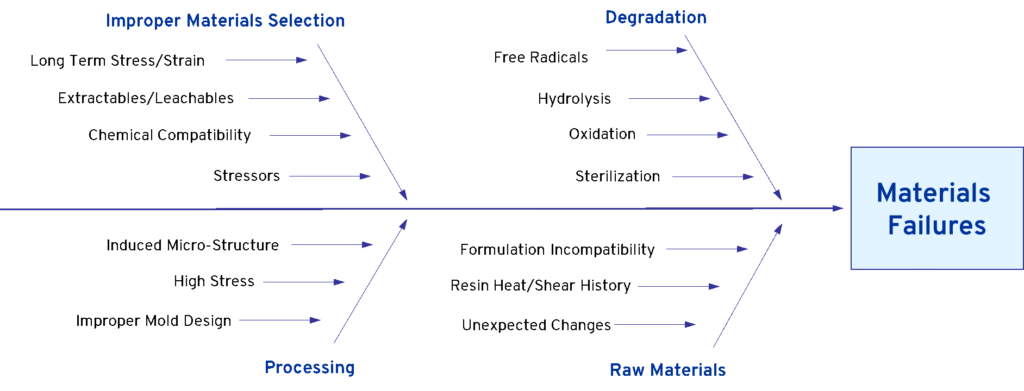

Choosing materials for a new medical device or consumer product is not a trivial task; without proper care, costly late-stage issues can derail an entire program. Material failures for medical devices, for example, are common and costly; 30-40% of FDA recalls are due to material issues.1 These issues may include compatibility of the fluid formulation with contacting materials, biocompatibility of the materials with the patient, reduced fracture resistance, mechanical properties degradation, undesired aesthetic changes, and the effects of long term stress or stain. These failures and others are presented in Figure 1. To avoid these, you should incorporate a comprehensive materials selection and testing protocol early into the product design cycle.

Materials selection begins with writing a requirements document that incorporates the input from both the engineering team and the human factors team to ensure that the device will function and meet the user’s expectations. The engineering team must consider all conditions that the materials will experience from resin compounding, shipping, assembly/joining, storage, use, and disposal, while the human factors team must consider how people will interact with the device. These include considerations of human, mechanical, chemical, and thermal stresses exerted on the device, such as gripping the device, cleaning it with harsh sanitizing chemicals, or leaving it in a hot car.
Sometimes device manufactures, design firms, and injection molders have preferred polymer vendors. While many times their vendor has the best material for the application, sometimes they do not. This is where an unbiased third-party review of device materials can give a broader perspective of which polymers are better suited to meet all the requirements for the device.
The requirements document and the Failure Modes and Effects Analysis (FMEA) document are then used along with material datasheets to select materials that will be suitable for all conditions the product will encounter. There is always a gap between the requirements and the data sheet information because resin manufacturers cannot test their polymers under all conditions. This is where additional testing under real-world conditions must be performed to challenge the viability of the top material candidates.
All concerns for product viability must be tested to best mitigate failure risk. Polymer testing requires considerations under actual use conditions. Examples of this include:
- Measuring fluid absorption into the polymer and its corresponding effect on mechanical properties by Instron testing
- Determining the efficacy of the fluid in the device after contact with materials by measuring its remaining activity
- Assessing biocompatibility via ISO 10993 testing
- Measuring mechanical properties (Young’s modulus, ultimate tensile strength, strain at break, storage/loss modulus, tan delta etc.) at the highest and lowest temperatures the device will experience by Instron and dynamic mechanical analysis (DMA) testing
- Consideration of joining applications during assembly and the material related properties necessary to their success, such as melt flow index of dissimilar polymers joining by ultrasonic welding or energy absorption of the materials for laser transmission through welding
- Monitoring environmental stress-cracking while exposed to liquid formulation or cleaners by a static bend and soak test
- Estimating long term stress relaxation or creep using time-temperature superposition (TTS) from data obtained on a dynamic mechanical analyzer (DMA)
- Implementing accelerated aging of whole devices, followed by inspection and testing, to understand system level issues
These tests will reduce the risk for both product failures in late stage development and costly recalls after product launch. Despite the added time and cost, imposing the discipline of these analyses will help avoid embarrassing and costly recalls later. To realize the full cost savings potential this material selection protocol must be implemented early in the product development.
For more information, contact Jeff Ellis at [email protected].
To read other articles by Jeff about avoiding material failures in plastic products, click here.